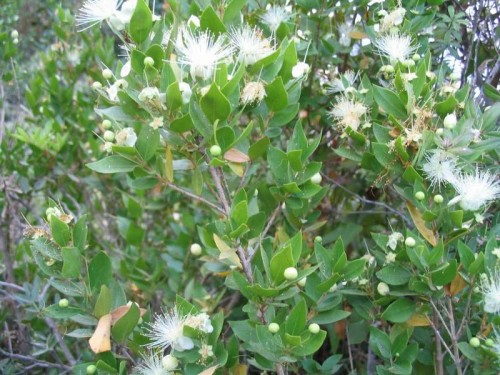|
MYRTLE AND BOX >> Appreciation of order, gratitude, humility and patience
 Two evergreen shrubs are these, hardly attaining the size of trees, but valued as pretty ornaments of the garden. The wood of the box has always been a favorite for its close grain and golden color; and it is said that boxes were first made from it, and that the very name “box” is only the ancient name of the tree, “pyxos,” slightly modified. Of boxwood, hitherto, the blocks for wood engraving have been made almost exclusively. The close foliage of the box has invited the shears of the gardeners, and caused it to be cut into borders and all manner of curious shapes, in all of which it retains a close, solid appearance. The myrtle, besides its bright, clean foliage, is valued also for its fragrant white or rosetinged flowers, and sweet-flavored berries. Of myrtle bridal chaplets were made in old time, and also crowns for the victors in bloodless contests. The Muse of Love and Marriage Songs wore a wreath of myrtle and roses, which were also sacred to Venus. Two evergreen shrubs are these, hardly attaining the size of trees, but valued as pretty ornaments of the garden. The wood of the box has always been a favorite for its close grain and golden color; and it is said that boxes were first made from it, and that the very name “box” is only the ancient name of the tree, “pyxos,” slightly modified. Of boxwood, hitherto, the blocks for wood engraving have been made almost exclusively. The close foliage of the box has invited the shears of the gardeners, and caused it to be cut into borders and all manner of curious shapes, in all of which it retains a close, solid appearance. The myrtle, besides its bright, clean foliage, is valued also for its fragrant white or rosetinged flowers, and sweet-flavored berries. Of myrtle bridal chaplets were made in old time, and also crowns for the victors in bloodless contests. The Muse of Love and Marriage Songs wore a wreath of myrtle and roses, which were also sacred to Venus.
The sweet-scented and ornamental shrubs represent a modest and pleasing intelligence, not intent upon important works, like that represented by the fruit trees, nor yet simply upon the acquisition of useful knowledge, like the spiritual timber trees; but content to apprehend intelligently, and present acceptably the virtues of life, as order, gratitude, humility, patience, friendship, and the like. Their very fragrance and beauty show that they represent some spiritual pleasantness or beauty; and the human qualities which are spiritually pleasant and beautiful are such virtues. The considerable size and longevity of the shrubs indicate a corresponding elevation and permanence of the correlative intelligence.And among such varieties of intelligence, that concerning the value of order seems indicated by every characteristic of the box. The very name, and the fact of its long-recognized adaptation for the use which the name stands for, is an acknowledgment of the spirit that animates it; as is likewise its employment for borders in gardens. Its foliage—bright, clean, rigid, and evergreen—expresses as well as foliage can, the unremitting attention of such intelligence to details of neatness and propriety. The perfection with which it preserves the forms into which ithas been cut indicates the same formal spirit; and it is a similar quality in the close-grained wood, which especially adapts it to engravers’ purposes.
The more graceful and fragrant myrtle expresses a more graceful and pleasant intelligence than that of the box, more closely related to active affections. Its ancient employment for chaplets of brides, and its association with roses in the adornments of the Muse and the Goddess of Love, suggest the variety of intelligence represented; which must not be confounded with that of orange flowers, with their generous fruits of wisdom concerning marriage, but perhaps rather resembles the delicate beauty and less important fruitfulness of what Swedenborg calls “the chaste love of the sex,” which is the introduction to marriage love, and afterwards its modest companion.
The myrtle is a sister to the pomegranate; and we have seen that pomegranates correspond to an abundant natural usefulness based upon Christian charity. The myrtle, more graceful and fragrant, though less showy in blossoms and fruit, must correspond to intelligence concerning some kind of affection, less practical, but more graceful and sweeter, and probably, as has been indicated, a pure affection between men and women. The love which we call “Platonic,” which Plato understood as a love for beauty of mind, in either sex, indicative of intelligent receptiveness, and which delights in the stimulus of such beauty to intelligence and virtue, is not very far from the soul of the myrtle.
Author: JOHN WORCESTER 1875
|
|